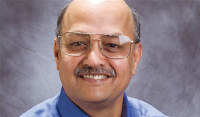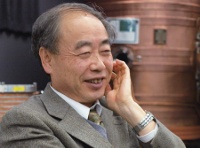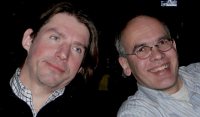 |
|
|
 |
From CERN Courier: Viewpoint: SRF technology comes full circle
Accelerator builders should step back and re-assess decades of R&D into superconducting RF technology says Jefferson Labís Ganapati Rao Myneni.

Jefferson Lab's Ganapati Rao Myneni |
Nearly a half-century ago, researchers at Stanford University began investigating superconducting RF (SRF) acceleration.
They would not have been surprised to learn that by 1994, SRF had come into large-scale use in Jefferson Lab's
Continuous Electron Beam Accelerator Facility, or that by 2008 it was planned as the enormous, ultra-cold,
dynamic-but-delicate heart of the proposed International Linear Collider (ILC).
Nor would they be surprised
to learn that this complex technology's challenges nevertheless continue to vex accelerator builders.
In my view, it's time for the accelerator community to go back to where the pioneers at Stanford began,
hit the pause button,
and take a careful look at more than four decades of SRF R&D.

At high magnification, the micrograph shows the many submicron grain
boundaries in polycrystalline niobium after expensive modern-day processing. Photo: DESY |
Such a renewed learning effort is needed because SRF technology is not only complex and vexing, itís vital and expensive. Some 16,000 SRF accelerating cavities will be made for the ILC from hundreds of tons of the soft, ductile metal niobium, which becomes superconducting when refrigerated to nearly absolute zero. This is a major component of the ILCís immense cost.
Read more...
-- Ganapati Rao Myneni, Jefferson Lab and University of Virginia |
 |
|
|
 |
|
 |
Understanding something new — interview with Makoto Kobayashi
This interview was originally done for November issue of the "ILC Tsushin", the Japanese newsletter for non-scientific readers.

Makoto Kobayashi during the interview at KEKB exhibition hall (credit: Nobuko Kobayashi) |
It has been hectic days for Makoto Kobayashi, Professor emeritus at KEK, since 7 October, the announcement of 2008 Nobel Prize in physics. Now that one month has passed, Kobayashi finally gets to settle down a little (or he has gotten used to keeping up with a demanding schedule), he shared his time to talk about the future of accelerator science with ILC NewsLine.
Read more...
-- Interview by Rika Takahashi |
 |
|
|
 |
What is it? Sparkling water...

Allright, this one was too hard. There are no winners for the 'What is it' competiton,
so here is the explanation from the team that noticed this strange effect while
commissioning a high-pressure rinse for cavities at Argonne:
"When two non-conductive materials rub together they generate static electricity due
to the removal of surface charges (electrons) from one material to the other.
In the commissioning of the High Pressure Rinse at Argonne National Lab,
the de-ionised and therefore non-conductive (ultra-pure) water rubs against
the surface of the plastic cavity mock-up made of polycarbonate (Lexan),
creating a surface charge imbalance due to which the polycarbonate becomes
electrically charged to the water. The great amount of static electricity creates a charge imbalance.
The surrounding water becomes ionised (a plasma) and the plastic is discharging
its electricity through a corona effect. What we see in the picture is the light
of the corona generated by a spray of highly pressurised and ultrapure
water (1,250 psi) against the polycarbonate cavity mock-up.
The continuous spark produces ozone which, with his characteristic odor, permeates the clean room."
Luciano Elementi and his colleagues from Fermilab
Do you have puzzling pictures with an ILC background? Send them and a short
explanation to communicators@linearcollider.org!
|
 |
|
|
 |
From Irish Times
25 November 2008
Scientists hope to discover secret world inside atoms
...The results of these [LHC] experiments will inform us not only about the structure of atoms but also about the structure of the universe.
Read more... |
|
From PhysOrg
24 November 2008
Physicists Receive Patent for Improved Cancer Therapy Device
...Rapid cycling allows proton beams to be injected and extracted from the synchrotron in just one turn around the circular particle accelerator. Unlike the earlier machines, which required multiple turns, this eliminates the need for sensitive feedback systems to control the beam currents.
Read more... |
|
From AFP
20 November 2008
e=mc2: 103 years later, Einstein's proven right
...It's taken more than a century, but Einstein's celebrated formula e=mc2 has finally been corroborated, thanks to a heroic computational effort by French, German and Hungarian physicists.(...) The odd thing is this: the mass of gluons is zero and the mass of quarks is only five percent. Where, therefore, is the missing 95 percent?
Read more... |
|
From Symmetry Magazine
November 2008
Dark universe debate
Who will be the first to prove the existence of dark matter and dark energy? A particle physicist and an astrophysicist go head to head.
Read more... |
|
From Symmetry Magazine
November 2008
Rapping Physics
...it would be nice if scientists who write about their work on blogs or craft articles for an outreach Web site could see those efforts valued on an equal footing with the hours they spend coding software, for instance.
Read more... |
|
|
 |
Progress on our Technical Design Phase goals
Today's issue features a Director's Corner from Marc Ross, Project Manager for the Global Design Effort.

XFEL Technical Coordinator Thomas Hott and Lars Hagge, leader of the XFEL work package 'Information & Process Support'. |
Last week several hundred scientists and engineers gathered at the new Forum Event
Center of the University of Illinois at Chicago for LCWS 08 and ILC 08.
Once per year the Global Design Effort hosts a plenary meeting to which the
entire community is invited to hear progress, plans and general presentations,
and for 2008 this meeting was ILC08.
The last such meeting was the very successful LCWS07
held in June 2007 at DESY. Although our venue was a rather brisk downtown Chicago in November,
the meeting was warm and convivial and, I believe, as successful as LCWS07.
Read more...
-- Marc Ross
Director's Corner Archive |
 |
|
|
 |
|
Early edition of NewsLine this week
Due to the Thanksgiving Holiday in the United States this Thursday,
the ILC Communicators are sending you an early edition of ILC NewsLine this week.
The publication will return to its normal schedule next week.
The symmetry challenge: Physics on a napkin
from symmetry magazine

We've all heard the stories of great ideas first scribbled down in a bar on any convenient surface,
often a cocktail napkin.
We've also heard many cases of colleagues in bars asked to describe just what it is they do.
Lacking a whiteboard or chalkboard to draw on, the cocktail napkin comes to the rescue again.
So here's the challenge: Describe your own physics research in 60 seconds, along with a photo,
scan, or the original of a cocktail napkin with whatever scrawlings help tell your story.
The explanation can be in the form of a 60-second audio or video file or up to 200 words of text.
E-mail entries to symmetry or mail them care of David Harris, Communications Office,
SLAC National Accelerator Center, MS 58, 2575 Sand Hill Road, Menlo Park, CA 94025.
Symmetry
will send a prize to the author
of the clearest, most entertaining entry and explanation and show a selection of the best in the magazine.
arXiv preprints
0811.2136
Flavour Changing at Colliders in the Effective Theory Approach
0811.2020
Simulation Study of the Beam Calorimeter in the GLD Configuration for the Next Generation Linear Collider
EUROTeV Report
2008-063
Results of the EUROTeV Post Collision Line Design (PCDL )Task
|
|

